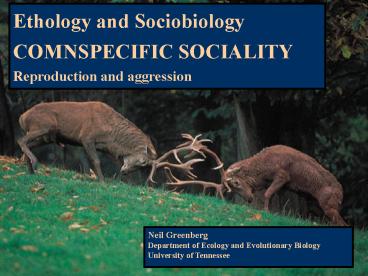Ethology and Sociobiology - PowerPoint PPT Presentation
1 / 13
Title:
Ethology and Sociobiology
Description:
Title: PowerPoint Presentation Author: Administrator Last modified by: greenberg Created Date: 11/6/2001 2:39:05 AM Document presentation format: On-screen Show (4:3) – PowerPoint PPT presentation
Number of Views:190
Avg rating:3.0/5.0
Title: Ethology and Sociobiology
1
Ethology and Sociobiology COMNSPECIFIC
SOCIALITY Reproduction and aggression
Neil GreenbergDepartment of Ecology and
Evolutionary BiologyUniversity of Tennessee
2
Social behavior is based on communicationdetectio
n of signals from the internal or external sense
organs
DEVELOPMENT (e.g., when in an animals life does
signal detection (or lack thereof) occur can it
be influenced by experience? Seasons? Hormones?)
(e.g., when sense organ is mature but it might
need environmental stimulation to do
that!) ECOLOGY (e.g., can signal detection be
influenced by the abiotic or biotic context)
(e.g., when sense organ is mature but it might
need environmental stimulation to do that!)
3
Social behavior is based on communicationdetectio
n of signals from the internal or external sense
organs
EVOLUTION (e.g., what capacities have been
transmitted from prior generation(s) and what
capacities will be passed on? (ritualization and
sensory exploitation perceptual bias genes
from ancestors, memes from ancestors, caregivers,
peers) PHYSIOLOGY (e.g., what is the
more-or-less proximate cause within the
individual?) (e.g., endocrine condition sex
/or stress)
4
AGGRESSION
- Once a unitary concept different forms of
vigorous vigorous activity undertaken to
control another animal were not discriminated.
- BUT it was found that not only was there a
diversity of stimuli that would evoke aggression,
- but the aggressive response was integrated and
relied upon different parts of the central
nervous system and specific physiological pre
conditions the neuromodulating influence of
stress and sex hormones
5
ECOLOGY of AGGRESSION
- Territorial aggression
- Protect space (or time?)
- Parental aggression
- Protects juveniles
- Parent-offspring Aggression
- Controls juveniles
- Sexual aggression
- Controls females
- Instrumental aggression
- Learned / past reinforcement
- Xenophobic aggression
- Fear of strangers
- Moralistic Aggresion
- Enforces social norms
- Predatory aggression
- feeding
- Anti-predatory aggression
- prey defenses
- Dominance aggression
- Establishes hierarchy
- Isolation-induced aggression
- Stress-evoked?
- Fear-induced aggression
- Stress-evoked?
- Irritable aggression
- Stress-evoked?
6
PHYSOLOGY of AGGRESSION
- Nervous system
- Stimulates hormone secretion
- Cells neuromodulated to be more-or-less
responsive to other influences
- Endocrine system
- Mainly sex and stress steroids
- Secretion evoked by nervous system
- Affects nervous system when it gets in circulation
- Interaction of Neurons and Hormones
7
EVOLUTION of BEHAVIOR
- In animals, almost invariably, a change in
behavior is the crucial factor initiating
evolutionary innovation (Ernst Mayr 1988). - Behavior creates new selective pressures (Mark
Baldwin via Deacon 1998)
8
The evolution of communicative signalsRITUALIZATI
ON
- The response of signals to selection pressure
to become more precise, less ambiguous . . . - Any behavioral pattern is a candidate for
ritualization if it can communicate information
by any modality (sound, sight, chemosensory ) - Fragments of motor patterns or autonomic nervous
system functions - Begins with the multitasking of any detectable
function that can communicate information about
the internal state of an animal that might affect
its behavior
9
The evolution of communicative signalsRITUALIZATI
ON
- MOTOR PATTERNS (somatic)
- Intention movement of (e.g.) body, limbs, ears,
tail - Ambivalent Posture or movement . . . raising or
lowering head (e.g., dominance) - AUTONOMIC REFLEXES
- Alimentary Increase or decrease in salivation.
Sphincter control, urination, defecation. (e.g.,
territorial marking) - Circulatory Pallor, flushing, vasodilation of
sex organs. Fainting.(e.g., skin patches) - Respiratory Changes in respiratory rate or
amplitude. Gasping, sighing, panting. (e.g.,
inflation displays, hissing, speech (?) - Thermoregulatory Sweating, pilomotor responses.
(e.g., hair or feather erection, scent signals)
Electrodermal response - Lacrimatory weeping.
10
The Peacocks Tail
- raised by feather pilomotor muscles
- an ancient autonomic thermoregulatory mechanism
- Ordinarily hidden
- displayed when aroused
11
The Lizards Flag
- Effected by the hyoid apparatus
- An ancient mechanism activated by stress
- Ordinarily hidden
- displayed when aroused
12
The Lizards COURTSHIP a hypothetical scenario
- Continuing seasonal and experiential influences
on stress and sex hormones - Males emerge engage in territorial aggression
- Male dominance relationship established
- Females emerge and are courted by territorial
male - First female response is wary but becomes more
tolerant
13
The Lizards COURTSHIP a hypothetical scenario
- Continuing seasonal and experiential influences
on stress and sex hormones
- Environmental change effects change
- Behaviors of male and female become elements in
each others environment































